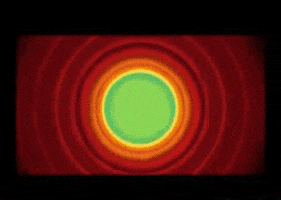This fused-glass, jellyfish mobile was created for my daughter-in-law using a bubble-producing medium, sandwiched between 2 layers of glass. The piece required 2 firings, multiple drillings and a bit of engineering to complete. Crystals and glass beads were added as embellishments and to effect prism-reflections when caught by sunlight.

Navigation
Install the app
How to install the app on iOS
Follow along with the video below to see how to install our site as a web app on your home screen.
Note: This feature may not be available in some browsers.
More options
You are using an out of date browser. It may not display this or other websites correctly.
You should upgrade or use an alternative browser.
You should upgrade or use an alternative browser.
Ended Official BYC 2024 Summer Fair—Handcrafts Show
- Thread starter azurbanclucker
- Start date
Fused glass pieces are rarely fired only once.Amazing finished product! May I ask if glass is typically only fired once? What do the additional firings do?
In the case of this frit-stretched bowl, higher-than usual, initial temperatures were employed, as many stacks of glass, and a glass dam were necessary for the technique used. The thickness of the piece required a very slow firing schedule, to avoid shock and breakage. Then the piece was taken to the saw and grinder to cold-work, or shape the edge. Because the edge became rough from the cold-working, and because it was so thick from having been dammed, it was returned to the kiln for second, full-fuse firing. Glass, in its liquid state, wants to "pull" or "spread" to a thickness of 6mm. The dam used in the initial firing prevented that. Then it went back to the kiln a third time, over a bisque mold, to achieve it's shape in a medium-temperature "slump" firing.
Did that make sense?
And this is an oil-stained, acrylic-stenciled and hand-lettered fireplace screen that I painted for my dining room fireplace.

Not an entry - just wanted to share this piece (small bowl) made with a rainbow, iridescent base, translucent, yellow cap and bubble-producing medium, sandwiched between. Etching a swirl into the medium allowed for a variance of bubble sizes within the pattern. But if you enlarge the photo - you see thousands of tiny bubbles, throughout the glass.
I love glass bubbles ♡

I love glass bubbles ♡
Perfect good sense - quite the process and it sounds like it must be very patient craftsmanship. Thank you for taking the time to explain so thoroughly!Fused glass pieces are rarely fired only once.
In the case of this frit-stretched bowl, higher-than usual, initial temperatures were employed, as many stacks of glass, and a glass dam were necessary for the technique used. The thickness of the piece required a very slow firing schedule, to avoid shock and breakage. Then the piece was taken to the saw and grinder to cold-work, or shape the edge. Because the edge became rough from the cold-working, and because it was so thick from having been dammed, it was returned to the kiln for second, full-fuse firing. Glass, in its liquid state, wants to "pull" or "spread" to a thickness of 6mm. The dam used in the initial firing prevented that. Then it went back to the kiln a third time, over a bisque mold, to achieve it's shape in a medium-temperature "slump" firing.
Did that make sense?
*Edit to add how lovely the glass pieces are!
Thank you! ♡ The thing I love most about glass fusing is that there is always, always something new to learn! But, dang! It's an expensive hobby!Perfect good sense - quite the process and it sounds like it must be very patient craftsmanship. Thank you for taking the time to explain so thoroughly!
*Edit to add how lovely the glass pieces are!
- Thread starter
- #97
Reminder! Sunday Aug 25th is the last day to enter!
- Thread starter
- #98

This contest has officially ended. Judges will be making rounds soon and we will get winners announced ASAP.
Thanks to all the participants and to all of our Volunteer Project Managers who help keep these contests moving smoothly.
Beautiful! The contest allows for five pictures. Which five do you want judged?A beautiful crocheted bouquet of carnation and snowdrop flowers!
These were made with acrylic worsted weight size 4 yarn and a 5mm hook.
They have yarn wrapped wire stems and jewelry wire in the leaves to make them more realistic.
This was my first ever attempt at crochet flowers and they were a gift for my baby cousin that was born in January






| 1 | 2 | 3 | 4 | 5 | 6 |
Oops sorry... I didn't realize it uploaded a couple photos twiceBeautiful! The contest allows for five pictures. Which five do you want judged?
1 2 3 4 5 6 







You can remove photos 5 and 6 (since they're duplicates) and judge the rest! Sorry I truly wasn't trying to make it harder on you
New posts New threads Active threads
-
Latest threads
-
My pullet is acting lethargic.
- Started by Burnttoast5475
- Replies: 0
-
Black Friday shed deals for coop?
- Started by Triangle Nostril
- Replies: 0
-
-
What is wrong with my chicken - blackhead?
- Started by Crazy Chicken Keeper
- Replies: 2
-
-
-
Threads with more replies in the last 15 days
-
-
-
Ended BYC Poultry Caption Contest 11-07-25 Pic by kattabelly
- Started by TwoCrows
- Replies: 53
-
-
UPDATED serious flystrike
- Started by anomala
- Replies: 52
-
×

